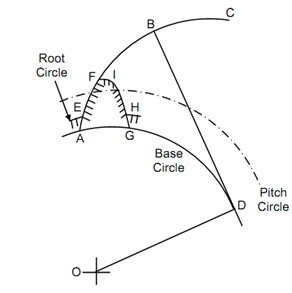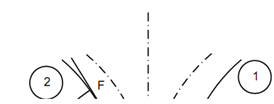Involute Profile Teeth:
An involute is the locus of a point on a straight line that rolls without slipping on the circumference of a circle that is called base circle. It is also described as the path traced by the end of a tant cord while it is unwound through the circumference of a circle.
Given fig show an involutes generated by a rolling line. Involutes begin at point A of the base circle and like the straight line rolls, the involutes ABC is produced. The normal to the involutes at a point say B is the rolling straight line itself and in this case it is BD. this is the line drawn tangent to the base circle from point B. In general, a portion of involutes say EF may be utilized to make the profile of an involutes tooth. The other side of the tooth HI may be taken from involutes drawn from G in the reverse direction.

Involute Profile and Involute Tooth
This may be noted down that unlike cycloidal tooth profile, the profile of an involutes tooth is built up of a single curve.
Given fig shows two gears 1 and 2 having centers of rotation at O1 & O2. They are in contact at C. The line ECF is common tangent to the two base circles. The involutes DC is produced by the rolling line CF on base circle of gear 2 and GCH is produced by the rolling line EC on base circle of gear 1. The lines CF & EC are segments of the line EF. From the property of the involutes, the tangent CF shall be normal to the involutes DC and the tangent EC shall be the normal to the involutes GCH. Therefore, the common tangent to the two base circles is common normal at the point of contact C and this passes through the pitch point P. Since the gear 1 rotates the point of contact among the pair of teeth moves along the line EF that always passes through the pitch point P. thus, the involutes follows law of gearing.
As the common normal is the line EF that is tangent to the two base circles, the pressure angle in this case remains constant during the engagement of the two teeth. The standard values of the pressure angles are following 14.5o, 20o and 25o.

Transmission of Motion in Involutes Gears